One sign of a coolant leak in a Jeep Wrangler is puddles of coolant under the vehicle. Another indication is the engine overheating frequently, which signals a potential coolant leak.
This issue can stem from a variety of causes, such as a cracked radiator, loose hose connections, or a blown gasket. Identifying and promptly addressing coolant leaks is crucial for maintaining the performance and longevity of your Jeep Wrangler. We’ll explore the signs of a coolant leak in a Jeep Wrangler and provide guidance on troubleshooting and addressing this issue to ensure your vehicle stays in optimal condition.
Understanding these signs can help you take timely action to prevent more severe damage to your Jeep Wrangler’s engine and cooling system.
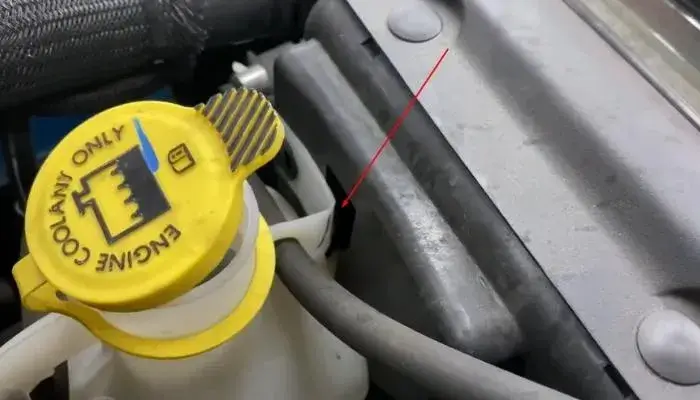
What is a Coolant Leak?
When it comes to your Jeep Wrangler, spotting a coolant leak is crucial in maintaining the health of your vehicle. A coolant leak occurs when the coolant, essential for regulating the engine’s temperature, escapes from the cooling system.
This can result from various issues such as a damaged hose, radiator, or faulty gasket. Signs include puddles of coolant beneath the vehicle, a sweet smell, or overheating. Promptly addressing coolant leaks is crucial to prevent engine damage and ensure the proper functioning of your Jeep Wrangler.
1. Importance Of Coolant In A Jeep Wrangler
Coolant, also known as antifreeze is a critical component for maintaining the health and performance of your Jeep Wrangler’s engine. It serves multiple crucial functions that ensure your vehicle runs smoothly both on and off the road.
First and foremost, the coolant acts as a heat dissipater, preventing your engine from overheating during operation. This helps to protect sensitive engine components from damage and ensures optimal performance.
Additionally, coolant contains additives that provide lubrication to various engine parts, reducing friction and wear. This not only prolongs the lifespan of your engine but also contributes to smoother operation and improved efficiency.
Furthermore, coolant helps to prevent corrosion and rust within the engine system, safeguarding its integrity and longevity. Regularly monitoring coolant levels and addressing any leaks promptly is essential to avoid costly repairs and maintain the reliability of your Jeep Wrangler.
Common Causes Of Coolant Leaks in Jeep Wrangler
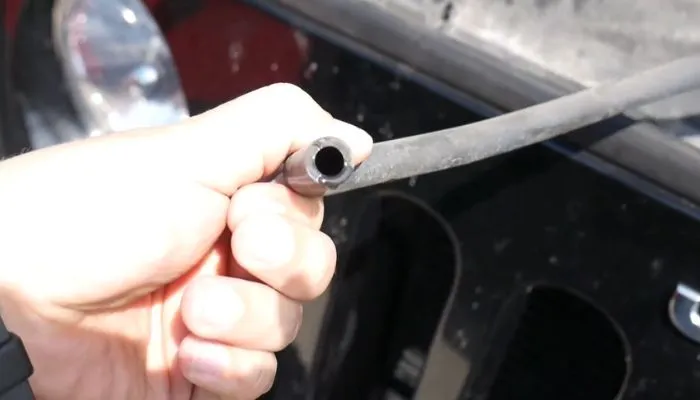
1. Leaky Hoses
Your Jeep has a bunch of rubber hoses carrying coolant all over the engine. Think of them like the veins of your cooling system. Over time, they can get brittle, crack, or get damaged by things kicked up from the road. Check those hoses closely – any wet spots, bulges, or obvious cracks mean it’s time for a replacement.
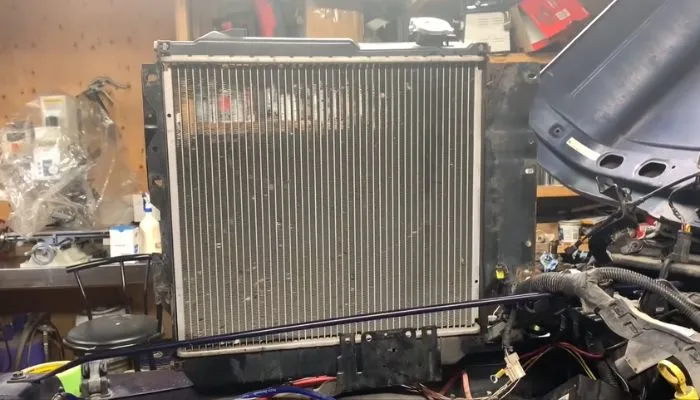
2. Radiator Trouble
Your radiator is like a giant heat exchanger, helping keep your engine cool. Unfortunately, they can take a beating from rocks, bugs, or just get old and corroded. Look out for any dripping coolant, especially at the front of your Jeep where the radiator sits.
3. Water Pump Woes
The water pump is the heart of your coolant system, pushing that fluid around. When its seals start to leak, you’ll often see coolant near the front of your engine. Listen closely, too – a failing water pump might make a squealing sound, which is a big warning sign!
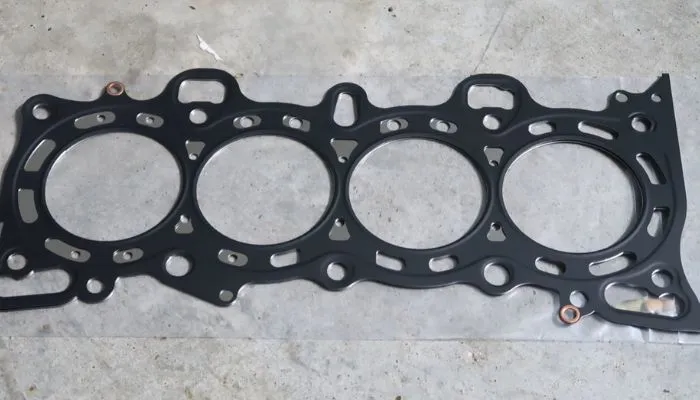
4. Head Gasket Headaches
This one’s a bit trickier. The head gasket is a seal deep inside your engine. If it fails, it can cause a hidden coolant leak. Look out for disappearing coolant without any puddles, or white smoke from your exhaust – those are signs of a possible head gasket issue.
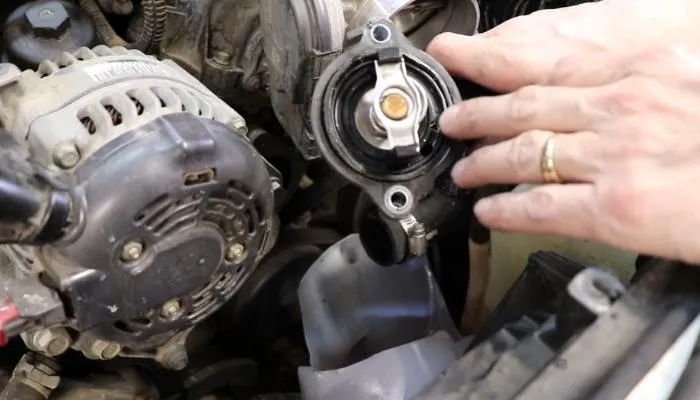
5. Thermostat Troubles
Picture your thermostat as your engine’s temperature control. It gets stuck or the housing around it cracks, and bam – coolant leaks out! You might find it dripping where your upper radiator hose joins the engine, plus your Jeep’s temperature gauge might be doing weird things.
Signs Of Coolant Leak In A Jeep Wrangler
Signs of coolant leak in a Jeep Wrangler can lead to serious issues if not addressed promptly. Identifying the signs of a coolant leak is crucial for maintaining the health and performance of your vehicle. Here are the key indicators to watch out for:
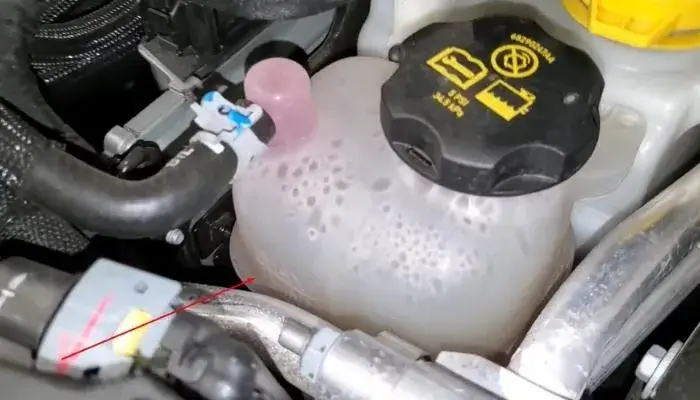
1. Low Coolant Level
A sudden drop in coolant levels could be a sign of a leak. Regularly check the coolant reservoir to ensure it is always filled to the appropriate level.
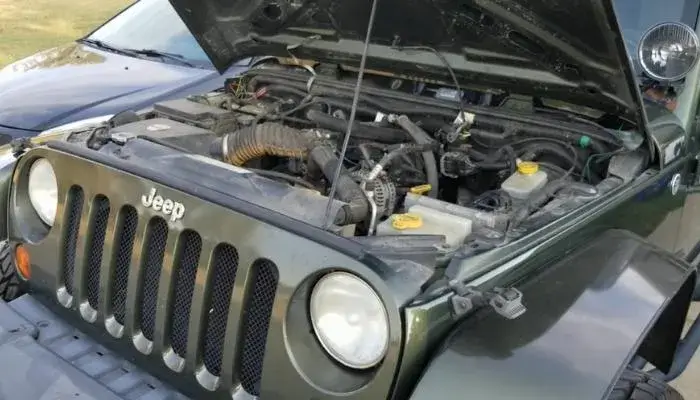
2. Overheating Engine
An overheating engine is a common consequence of low coolant levels caused by a leak. Keep an eye on the temperature gauge and address any anomalies immediately.
3. Sweet Smell Or Visible Fluid
If you notice a sweet smell or visible fluid around the engine compartment, it could indicate a leak. Coolant has a distinct, sweet odor that can help you detect a leak.
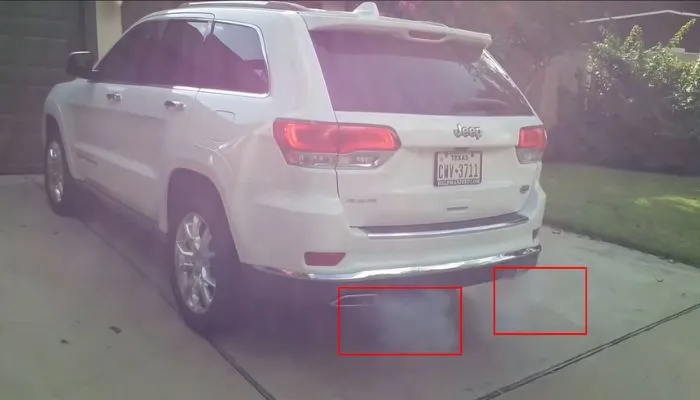
4. White Smoke From Exhaust
White smoke emanating from the exhaust could signal a coolant leak, as coolant may be entering the combustion chamber, resulting in the emission of white smoke.

5. Coolant Pool Under The Vehicle
Spotting a coolant pool beneath your vehicle is a clear sign of a leak. Inspect under the car for any puddles or stains indicative of a coolant leak.
Also Read: Is Engine Coolant the Same As Antifreeze
How To Identify The Source Of Coolant Leak
If your Jeep Wrangler is showing signs of a coolant leak, it’s important to identify the source quickly. Look for visible puddles of coolant under the vehicle, check the radiator hoses for cracks or leaks, and inspect the radiator itself for any signs of damage.
Regular maintenance and prompt repairs can prevent further damage to your vehicle’s engine.
Identifying the source of a coolant leak in your Jeep Wrangler is crucial for maintaining optimal engine performance. Ignoring a coolant leak can lead to overheating, engine damage, and expensive repairs. In this section, we will explore three effective methods to pinpoint the source of a coolant leak: visual inspection, pressure testing, and coolant dye test.
1. Visual Inspection
Performing a visual inspection is the first step to determine the source of a coolant leak. This method allows you to visually identify any visible signs of leakage, such as puddles or stains under your Jeep Wrangler. Follow these steps:
- Start by parking your Jeep on a clean and flat surface.
- Open the hood and inspect the engine compartment for any signs of coolant leakage.
- Look for wet or discolored areas around hoses, radiator, water pump, and thermostat housing.
- Inspect the coolant overflow reservoir for any signs of leakage, such as cracks or loose connections.
- If you notice any visible signs of coolant leakage, it is important to address the issue promptly.
2. Pressure Testing
Pressure testing is another effective method to locate the source of a coolant leak that may not be visible to the naked eye. This method allows you to pressurize the cooling system and detect any leaks under pressure. Here’s how to perform a pressure test:
- Make sure your Jeep’s engine is cool before proceeding.
- Remove the radiator cap and attach a pressure tester to the radiator or coolant reservoir.
- Pump the pressure tester to the recommended pressure level, usually specified in your Jeep Wrangler’s manual.
- Observe the pressure gauge on the tester. If you notice a drop in pressure, it indicates a coolant leak.
- Inspect the cooling system components, including hoses, connections, and the radiator, to locate the source of the leak.
- Repair or replace any faulty components or connections to rectify the coolant leak.
3. Coolant Dye Test
When visual inspection and pressure testing fail to identify the source of a coolant leak, a coolant dye test can be the solution. This method uses a specialized dye to detect small leaks that are not visible to the naked eye. Follow these steps to perform a coolant dye test:
- Purchase a coolant leak detection kit that includes a UV dye.
- Drain a small amount of coolant from your Jeep Wrangler’s radiator or coolant reservoir, as per the kit’s instructions.
- Add the UV dye to the cooling system through the designated opening.
- Run the engine for a specified period, as recommended by the kit’s instructions.
- Inspect the cooling system components with a UV light. The dye will fluoresce under the UV light, allowing you to identify the source of the coolant leak.
- Repair or replace the faulty component or connection to fix the coolant leak.
By performing a visual inspection, pressure testing, or a coolant dye test, you can determine the exact source of the coolant leak in your Jeep Wrangler. Identifying and addressing the issue promptly will ensure your engine remains cool and prevent further damage in the long run.
DIY Fixes For Coolant Leaks In A Jeep Wrangler
If you notice a coolant leak in your Jeep Wrangler, it’s important to address it promptly to prevent potential engine damage. DIY fixes for coolant leaks may include inspecting hoses, radiator, and water pump for visible signs of wear or damage, tightening hose clamps, or applying a sealant to small leaks.
Promptly addressing coolant leaks can help maintain the proper functioning of the Jeep Wrangler’s cooling system.
When you discover a coolant leak in your Jeep Wrangler, it’s important to take immediate action to prevent further damage to your vehicle’s engine. While professional assistance is always recommended for major repairs, there are a few DIY fixes you can try for minor coolant leaks. By addressing the issue early on, you can save money and ensure your Jeep stays running smoothly on and off the road.
1. Tightening Loose Connections
If you notice coolant leaking from connections within your Jeep’s cooling system, tightening them can help resolve the issue. Start by inspecting the hose clamps and fittings for any signs of looseness. Use a wrench or pliers to securely tighten them, ensuring a snug fit that prevents any leaks.
Remember, over-tightening can cause damage, so be cautious not to overtighten any connections, as this can lead to more problems.
2. Replacing Damaged Hoses
Damaged or worn-out hoses are a common cause of coolant leaks in a Jeep Wrangler. Inspect the hoses for any cracks, splits, or bulges. If you come across any damage, it’s best to replace the hose altogether. Remove the old hose carefully, ensuring you don’t damage any nearby components.
Install the new hose by securely attaching it to the appropriate connections, using hose clamps to hold it in place.
3. Fixing Leaking Radiator
A leaking radiator can be a cause for concern, but with some DIY know-how, you can address the issue yourself. Start by identifying the location of the leak on the radiator. This may require carefully inspecting the radiator for any visible cracks or holes.
Once you locate the leak, clean the area surrounding it and use a suitable radiator repair epoxy or sealant to patch the damaged area. Follow the manufacturer’s instructions and allow the sealant to dry completely before refilling the coolant.
4. Repairing Blown Head Gasket
A blown head gasket is a more serious issue that may require professional assistance, but if you’re experienced and confident in your abilities, you can attempt a DIY repair. Start by removing the engine cylinder head and inspecting the gasket.
If you notice any signs of damage or wear, it’s essential to replace the gasket with a new one. Clean the mating surfaces thoroughly before installing the new gasket and reassembling the components. Take extra care to ensure proper torque is applied to the cylinder head bolts to avoid any future leaks.
5. Addressing Faulty Water Pump
A faulty water pump can also lead to coolant leaks in your Jeep Wrangler. To tackle this issue, start by identifying the source of the leak, which may require removing some components to access the water pump. Once you locate the problem, determine if the issue can be resolved by replacing a damaged seal or bearing.
In some cases, it may be necessary to replace the entire water pump. Ensure you follow the manufacturer’s instructions carefully during the replacement process to prevent any further leaks.
When To Seek Professional Help
If you notice your Jeep Wrangler’s coolant levels dropping rapidly, it could be a sign of a coolant leak. Look out for any puddles or stains under the vehicle. If you detect these signs, it’s best to seek professional help to address the issue promptly.
Jeep Wranglers are known for their durability and off-road capabilities, but even the toughest of vehicles can experience coolant leaks. While some minor leaks can be fixed with a little DIY knowledge, there are certain situations where it’s best to seek professional help. Taking your Jeep to an experienced mechanic can save you time, money, and potential headaches down the road.
1. Complex Coolant Leak Issues
If you notice a persistent coolant leak and have already tried common DIY fixes like tightening the hose clamps or replacing a faulty gasket, it may be an indication of a more complex issue. Complex coolant leak issues can arise from damaged components within the cooling system or a failure of the radiator itself.
These complex problems often require specialized knowledge and equipment to diagnose and repair correctly.
2. Inability To Diagnose The Problem
Sometimes, coolant leaks in a Jeep Wrangler can be elusive. You may be unsure of the exact location or cause of the leak, even after performing visual inspections and basic troubleshooting. In these cases, seeking professional help from a mechanic who has experience with Jeep Wranglers is crucial.
They have the expertise and diagnostic tools to more accurately identify the source of the leak and recommend the appropriate repairs.
3. Major Engine And Cooling System Repairs
If you suspect that the coolant leak in your Jeep Wrangler is not just a minor issue but a symptom of a larger problem, it’s vital to consult a professional. Major engine and cooling system repairs are not only complex but also require specialized knowledge and experience.
Attempting these repairs without proper expertise can lead to further damage and more costly repairs in the long run. A skilled mechanic can assess the extent of the problem and provide the necessary repairs to get your Jeep back on the road safely.
Credit: wranglertjforum.com
Wrapping Up
To sum up, keeping an eye out for coolant leaks in your Jeep Wrangler is crucial for maintaining its performance and preventing potential engine damage. Detecting early signs, such as low coolant levels, overheating, or a sweet smell, can save you time and money in the long run.
Regularly inspecting your vehicle, seeking professional help, and promptly addressing any issues are key to enjoying a worry-free and reliable driving experience in your Jeep Wrangler.
FAQs
Q: Why Is My Jeep Wrangler Leaking Coolant?
A: A coolant leak in your Jeep Wrangler can be caused by a variety of factors, such as a faulty radiator, a worn-out hose, a cracked coolant reservoir, or a damaged water pump. It is important to address coolant leaks promptly to avoid engine overheating and potential damage.
Q: How Can I Identify A Coolant Leak In My Jeep Wrangler?
A: Look for telltale signs such as coolant puddles under your vehicle, a sudden decrease in coolant levels, an overheating engine, or a sweet-smelling odor inside the cabin. Inspect the radiator, hoses, water pump, and coolant reservoir for any visible signs of leakage or damage.
Q: What Are The Consequences Of Ignoring A Coolant Leak In My Jeep Wrangler?
A: Ignoring a coolant leak in your Jeep Wrangler can lead to serious engine damage. Coolant plays a crucial role in regulating engine temperature, so a leak can result in overheating, which may cause warped cylinder heads, blown head gaskets, or even engine failure.
Prompt repairs are essential to avoid costly repairs down the line.
Q: Can I Continue Driving My Jeep Wrangler With A Coolant Leak?
A: It is not recommended to drive your Jeep Wrangler with a coolant leak. Without the proper amount of coolant, the engine can overheat, leading to potential engine damage. It is best to stop driving, address the issue, and seek professional assistance to ensure the safety and longevity of your vehicle.

